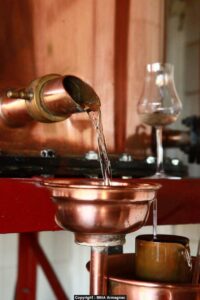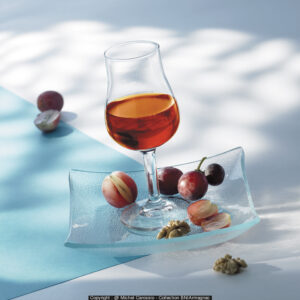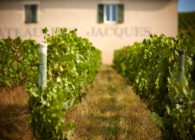France is well known for producing some of the world’s best (and most famous and expensive) wines. Yet, it is also known for producing some of the world’s greatest brandies, most notably Cognac, Armagnac, and Calvados, the latter being not a grape spirit, but one made from either apples or pears.
For grape spirits, Cognac and Armagnac rule the roost. Both are made in the Southwestern part of the country, below Bordeaux.
While Cognac, the distilled grape spirit made in the region of the same name, is probably the best known – and certainly most widely distributed – of France’s spirits, it is Armagnac, made south of Cognac in the rich gastronomic region of Gascony, that is the spirit considered by many to be the heart and soul of France’s brandies.
They’re both brandies made from grapes, so they must be similar, right? Not even close.
While Cognac for all intents and purposes is a well-oiled machine, with vast regulations, large corporate structure, and aging/labeling requirements that – for the most part – breed similarity between producers and brands; Armagnac, by contrast, is more like the little engine that could: a fiercely individualistic, sometimes forgotten, always appreciated spirit made by a handful of dedicated producers for whom the art of coaxing brandy from the vineyard’s ether is as integral to their regional identity as their exceptional culinary heritage.

Armagnac the region is divided into three sub zones: Bas Armagnac, Armagnac –Ténarèze, and Haut Armagnac. All make the spirit Armagnac, and the main grape varietals used in its production include Ugni Blanc, Folle Blanche, Colombard, and Baco (22A). Most Armagnac are created using a blend of grapes. While the majority of these grapes are also used to produce Cognac, it is the distillation that helps make Armagnac so unique, and individual.

For unlike Cognac production which favors the use of Pot Stills and double distillation, Armagnac production employs using Column Stills and is distilled only once, leaving a brandy with more fruit and fragrance than those of Cognac. Distilling once also leaves it a little rougher. Not a bad thing, though, as aging in oak alleviates that roughness over time, and brings out the subtleties and nuanced flavors of spice and dried fruit that make Armagnac so beloved.
Interestingly, much of Armagnac production is done employing the use of portable roaming stills that are taken from producer to producer, even those with their own stills, which often go unused. The idea behind this is that since getting the right spirit out of a still requires knowing how to work with it to create a preferred flavor profile, it makes more sense to let the person who “knows the still” make the product. One would think that this would make for a more homogenous product across the board, but it does the opposite, as it allows the process to be micro-tweaked to conform to a particular producer’s specific recipe. Which, in turn, helps make for much more individual end products.

So, what makes Armagnac worth searching out? Well, first, Armagnac is the oldest distillation of France, with records dating back to the 1300’s of brandy being made in the region. So, you’re drinking the history of France. Second, Armagnac is for the most part, very small production, with some producers making as little as 4000 bottles annually. So, you’re drinking someone’s handmade effort. Third, Armagnac producers don’t just use their vintage production to make the categorized blended brandies they sell (VSOP, XO, etc), they also bottle vintage Armagnac, which can be some of the most interesting (and costly) spirits you’ll try. So, you can, with some searching, probably own bottle of Armagnac from your birth year, making for some very interesting and delicious after dinner conversation.

Want to know more about this wonderful spirit? Tune in to The Connected Table LIVE! on Wednesday February 3 at 2:00p.m. We’ll be talking with In the Grape’s May Matta-Aliah, one of the country’s top wine educators, who is also the American Ambassador for the AOC Armagnac.



